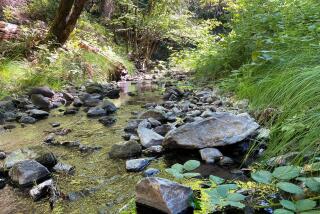U.S. to Study Farmers’ Pumping
- Share via
FRESNO — In a bow to congressional pressure, the U.S. Bureau of Reclamation will oversee a study to determine if cotton and melon farmers on the San Joaquin Valley’s vast west side are illegally siphoning billions of gallons of water from a federal reservoir.
For the past six years, farmers have supplemented their dwindling surface water supplies with water pumped from wells around the Mendota Pool, a 500-acre federal reservoir that is part of the Central Valley Project.
The farmers contend that their wells are pumping ground water, which is free for the taking. Critics say the wells are so close to the Mendota Pool--in some cases along the water’s edge--that the farmers are illegally siphoning water from the reservoir. This water, critics say, belongs to taxpayers and is worth $3 million to $7 million each year.
In response to a Times article last August in which two farmers acknowledged the siphoning scheme, U.S. Rep. George Miller (D-Martinez) chided the reclamation bureau for authorizing the practice and demanded that a study be undertaken to determine the extent of the diversions.
The reclamation bureau has agreed to oversee a $300,000 study, funded mostly by the farmers. It is expected to begin in the next few weeks.
“We hope it will confirm once and for all that there is no stealing of water going on,” said William Luce of the Bureau of Reclamation’s Fresno office.
But critics say the firm doing the study, Woodward-Clyde Consultants of Oakland, has little expertise in agricultural wells. Moreover, they charge, the reclamation bureau has narrowed the study in such a way that it may never answer the question of whether federal water is being commandeered.
“If you look at the bureau’s stated goal for this study, it has gotten narrower since the time Congressman Miller first requested action,” said Mike Sexton, a lawyer who manages four irrigation districts that share claim to the Mendota Pool water. “How are we going to get a definitive answer when they’re asking the wrong question?”
At the edge of the Mendota Pool, far from their crops, farmers who belong to the Westlands Water District have installed dozens of pumps that whirl and whine 24 hours a day, 300 days a year.
Because Westlands farmers have no way of conveying the pumped water to distant crops, they dump it back into the Mendota Pool and receive credits from the reclamation bureau. These credits allow the farmers to draw federal water from a source closer to their fields.
Miller, who heads the House Committee on Insular Affairs, wrote reclamation bureau officials in October requesting that they determine the source of the pumped water. The problem, federal geologists say, is that the Mendota Pool is not lined and some water--no one knows how much--seeps down and recharges the ground water aquifer. Once the pool water seeps down, the farmers say, it can be taken by anyone.
But Sexton and others argue that day and night pumping by Westlands farmers is so intense that any natural seepage is greatly accelerated. “By locating their wells around the Mendota Pool, the farmers have essentially created their own water bank,” Sexton said.
Sexton contends that pressure from corporate farmers caused the reclamation bureau to change the scope of the study. Now it plans to look only at whether the pumps increase seepage of pool water, not at the larger question of whether farmers are improperly obtaining federal water.
Reclamation bureau officials say the change in focus is insignificant but they agree that a final answer may be elusive.
“If water is being siphoned, how do you quantify it?” asked Chuck Howard, the bureau’s regional geologist. “It’s not an easy question to answer.”
More to Read
Sign up for Essential California
The most important California stories and recommendations in your inbox every morning.
You may occasionally receive promotional content from the Los Angeles Times.










